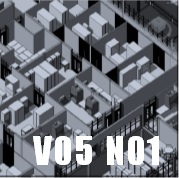Resumo
This paper presents an analysis of the Building Information Modeling implementation process in architectural and industrial design companies in Belo Horizonte. A field research was conducted interviewing professionals from industrial design and architectural design companies. The analysis was based on companies’ characteristics and tools used. Also, it was evaluated how implementation occurred, resulting benefits, challenges faced and designers perception of the process. A diversified BIM tools use was observed in different specialties on industrial design while on architectural design it was observed hegemony of tools. It was observed that the implementation of BIM, in the studied universe, is more developed in industrial design than in architectural design. Industrial design companies are already in the interoperability implementation stage, which is a higher BIM level than in architectural design companies. Architectural design companies are in the effort of leaving the traditional two-dimensional drawings towards parameterized 3D models. It was noted that industrial designers have a higher value perception regarding to parametric issues than architectural designers. Regarding of major reasons for adopting BIM, the perception of value among industrial designers and architectural designers is similar.The perceptions on the barriers to the adoption of BIM are basically antagonic for industrial and architectural designers. The most common way of software learning occurs through tutorials, forums and collaboration between peers. Among the proposed improvements presented by the interviewees it stands out the collaboration in team work and the commitment from the top management.
Referências
ARANTES, Eduardo M.; HOMERO JUNIOR, S.; D’ALMEIDA, Caio S. B. A experiência de implementação do Sistema Colaborativo SISAC para a Gestão de Projetos em uma Entidade Pública. In: ENCONTRO DE TECNOLOGIA DE INFORMAÇÃO E COMUNICAÇÃO NA CONSTRUÇÃO, 5, 2011, Salvador. Anais… Salvador: UFBA, 2011.
BECERIK-GERBER, Burcin; KENSEK, Karen. Building Information Modeling in Architecture, Engineering and Construction: Emerging Research Directions and Trends. Journal of Professional Issues in Engineering Education and Practice, Reston, v. 136, n. 3, p. 139-147, jul. 2010. Disponível em: , Acesso em: 19 ago. 2014
COMPUTER Integrated Construction Research Program. BIM Project Execution Planning Guide. Version 2.0, The Pennsylvania State University, University Park, PA, USA, abr. 2012. Disponível em: <http://bim.psu.edu/default.aspx>. Acesso em: 21 jul. 2014.
DUBOIS, Anna; GADDE, Lars-Erik. The construction industry as a loosely coupled System: Implications for productivity and innovation. Construction Management and Economics, London, v. 20, n. 7, p. 621-631, 2002. Disponível em< http://dx.doi.org/10.1080/01446190210163543>. Acesso em: 26 ago. 2014.
EASTMAN, Chuck et al. BIM handbook: a guide to building information modeling for owners, managers, designers, engineers, and contractors. Hoboken, NJ: Wiley, c2008. 490 p. :, il. ISBN 9780470185285 (enc.).
KHOSROWSHAHI, Farzad; ARAYICI, Yusuf. Roadmap for implementation of BIM in the UK construction industry. Engineering, Construction and Architectural Management, Bingley, v. 19, n. 6, p. 610-635. Disponível em < http://www.emeraldinsight.com/doi/full/10.1108/09699981211277531 >. Acesso em: 19 ago. 2014
KOSKELA, Lauri. An Exploration towards a Production Theory and its application to Construction. 2000. Dissertation (Doctor of Technology) – University of Technology, Helsinki. Disponível em: <http://www.vtt.fi/inf/pdf/publications/2000/P408.pdf >. Acesso em: 8 nov. 2010.
KOSKELA, Lauri. Application of the New Production Philosophy to Construction. Stanford: CENTER FOR INTEGRATED FACILITY ENGINEERING, set. 1992. 81 p. (CIFE Technical Report #72). Disponível em < http://www.ce.berkeley.edu/~tommelein/Koskela-TR72.pdf>. Acesso em: 8 nov. 2010.
LOVE, P.E.D.; GUNASEKARAN, A.; LI, H. Concurrent engineering: a strategy for procuring construction projects. International Journal of Project Management, [s.l.], v.16, n. 6, p. 375-396, dec. 1998, Disponível em: <http://www.sciencedirect.com/science/journal/02637863>. Acesso em: 26 ago 2014.
PAZLAR, Tomaz; TURK, Ziga. Interoperability in practice: Geometric data exchange using the IFC standard. ITcon, v.13, Special Issue Case studies of BIM use, p.362-380, 2008. Disponível em< http://www.itcon.org/2008/24>. Acesso em: 25 set. 2014.
RUSCHEL, Regina C.; ANDRADE, Max, L. V.; MORAIS, Marcelo. O ensino de BIM no Brasil: onde estamos? Ambiente Construído, Porto Alegre, v. 13, n. 2, p. 151-165, 2013. Disponível em <http://seer.ufrgs.br/ambienteconstruido/article/view/36881>. Acesso em: 19 set. 2014. http://dx.doi.org/10.1590/S1678-86212013000200012
SMITH, Dana K.; TARDIF, Michael. Building Information Modeling: a Strategic Implementation Guide for Architects, Engineers, Constructors, and Real Estate Asset Managers. 186 p. John Wiley & Sons, Inc., New Jersey, USA, 2009.
STEHLING, Miguel P. A utilização de modelagem da informação da construção em empresas de arquitetura e engenharia de Belo Horizonte. 2012. Dissertação (Mestrado em Engenharia) - Programa de Pós-Graduação em Construção Civil, Universidade Federal de Minas Gerais, Belo Horizonte.
TOBIN, John, Proto-Building: To BIM is to Build. AECbytes. Building the future. mai. 2008. Disponível em:. Acesso em: 26 out. 2010.
A PARC Pesquida em Arquitetura e Construção utiliza a licença do Creative Commons (CC), preservando assim, a integridade dos artigos em ambiente de acesso aberto.

